Things left to see
Rolling stock
Of the five locomotives, only no. 2, one of the O. & K. 0-6-0Ts, survives. This is now within the grounds of the old prison itself as part of the Maritime Museum. With it is the single coach.
Below are loco no. 2, and the coach, with the walls of a prison wing behind. Whilst the chimney appears to have rusted and shrunk, a close look at earlier pictures suggests it was built that way. Note the rear bunker- sagging a little, and that the wooden cab's side-screens have disappeared.
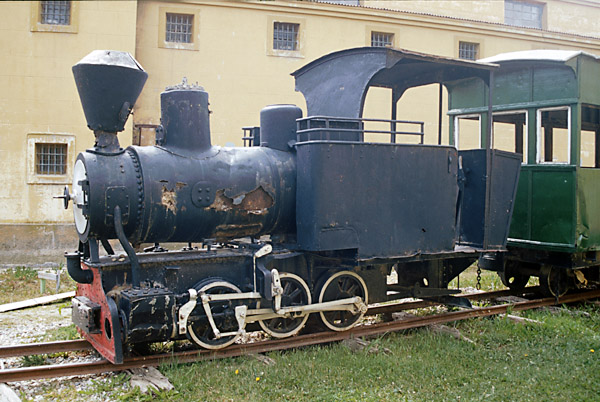
There is also a four-wheeled wagon chassis and wheels at the Museo del Fin del Mundo, as illustrated on the previous page.
The two diamond/archbar wagon bogies shown below have recently been placed on display at the FCAF's main 'Fin del Mundo' station.
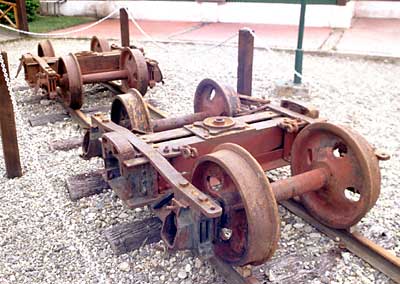
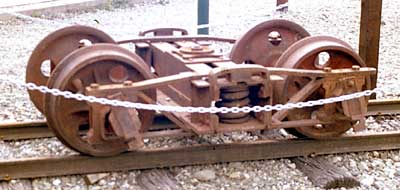
The old trackbeds
Within the town the railway used to run along Calle Maipu at the water's edge. There is nothing to see here now, but further out it is a different story. Obviously a small part of the 'mainline' westward has now been used by the 'End of the World Train' into the national park. The following photos show some of the old routes alongside this new track.
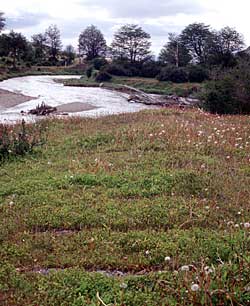 The FCAF's main station faces north. As the train leaves for the park, it curves left and joins the old prison railway track. This shot looking back eastward shows why the original route could not be used any further. The photographer was standing almost on the new track (with permission). The old sleepers are visible for a few yards but then the river has swept out fifty yards or so of embankment. The route passed just above the bigger branches in the river. Curving slightly left it picks up a surviving length of trackbed beyond a dark green bush down on the river bank. A large bridge has then been washed away and the embankment on the far side disappears into the distance behind a wooden pole. The FCAF's main station faces north. As the train leaves for the park, it curves left and joins the old prison railway track. This shot looking back eastward shows why the original route could not be used any further. The photographer was standing almost on the new track (with permission). The old sleepers are visible for a few yards but then the river has swept out fifty yards or so of embankment. The route passed just above the bigger branches in the river. Curving slightly left it picks up a surviving length of trackbed beyond a dark green bush down on the river bank. A large bridge has then been washed away and the embankment on the far side disappears into the distance behind a wooden pole.
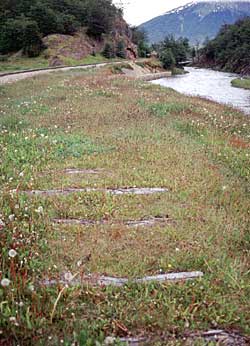 A bit further west (and looking west) the new track errs on the side of caution, leaving the old sleepers in their place as it runs a few yards further from the river's edge. In the distance the river passes under a new replacement bridge at 'Puente Quemado'. A bit further west (and looking west) the new track errs on the side of caution, leaving the old sleepers in their place as it runs a few yards further from the river's edge. In the distance the river passes under a new replacement bridge at 'Puente Quemado'.
The heading at the beginning of this sub-section was 'trackbeds' for of course there are many. The railway was not so much a line as a whole network. Within the old forest some lines would have been long-lived and well engineered whilst others were laid for a season to get the wood out. Here one of the more important routes branched off north into the upper parts of the Río Pipo valley. A few sleepers lie abandoned to mark the route. Note the stumps of old trees, almost certainly cut by the prisoners and shifted by train.
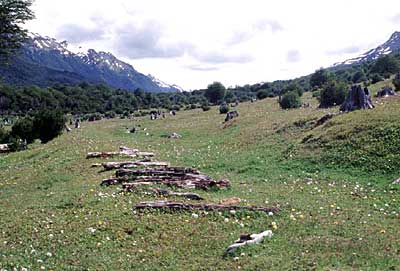
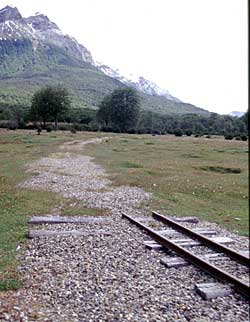 Not a future extension, merely a headshunt, but beyond can be seen the old trackbed again. There are many of these tracks, and some would no doubt repay exploring. For the non-railway-enthusiast they make excellent paths through the national park. Not a future extension, merely a headshunt, but beyond can be seen the old trackbed again. There are many of these tracks, and some would no doubt repay exploring. For the non-railway-enthusiast they make excellent paths through the national park.
Documentary and photographic evidence
The old railway is far from forgotten in Ushuaia. As well as the surviving artefacts there are many photographs on display:
There is a small but well-laid-out exhibition in the FCAF's carriage shed at their main station.
The Maritime Museum/Prison Museum in the old prison at the east end of town has obviously a much larger display of photographs of prison life, and many of these show the railway and the part it played in the community. They have their own website.
Finally, the Regional Museum (End of the World Museum) on Calle Maipu, is the holder of many original photos, all carefully catalogued and cared for.
Zagier and Urruty, "World's End' books, publish a number of publications about this part of the world. These include El Presidio de Ushuaia, a history of the prison in both Spanish and English with a large number of photos. They too have a website.
More photos
Whilst these two pages have covered most of the history of the railway, connoisseurs of prisons or railways can find a variety of other pictures on an additional appendix page. Click here to go to that appendix.
References:
Most photos on this page were taken during January 2001, with the pictures of the old wagon bogies taken by David Sinclair in December 2001.
26-5-08
|

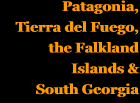







 The FCAF's main station faces north. As the train leaves for the park, it curves left and joins the old prison railway track. This shot looking back eastward shows why the original route could not be used any further. The photographer was standing almost on the new track (with permission). The old sleepers are visible for a few yards but then the river has swept out fifty yards or so of embankment. The route passed just above the bigger branches in the river. Curving slightly left it picks up a surviving length of trackbed beyond a dark green bush down on the river bank. A large bridge has then been washed away and the embankment on the far side disappears into the distance behind a wooden pole.
The FCAF's main station faces north. As the train leaves for the park, it curves left and joins the old prison railway track. This shot looking back eastward shows why the original route could not be used any further. The photographer was standing almost on the new track (with permission). The old sleepers are visible for a few yards but then the river has swept out fifty yards or so of embankment. The route passed just above the bigger branches in the river. Curving slightly left it picks up a surviving length of trackbed beyond a dark green bush down on the river bank. A large bridge has then been washed away and the embankment on the far side disappears into the distance behind a wooden pole. A bit further west (and looking west) the new track errs on the side of caution, leaving the old sleepers in their place as it runs a few yards further from the river's edge. In the distance the river passes under a new replacement bridge at 'Puente Quemado'.
A bit further west (and looking west) the new track errs on the side of caution, leaving the old sleepers in their place as it runs a few yards further from the river's edge. In the distance the river passes under a new replacement bridge at 'Puente Quemado'. 
 Not a future extension, merely a headshunt, but beyond can be seen the old trackbed again. There are many of these tracks, and some would no doubt repay exploring. For the non-railway-enthusiast they make excellent paths through the national park.
Not a future extension, merely a headshunt, but beyond can be seen the old trackbed again. There are many of these tracks, and some would no doubt repay exploring. For the non-railway-enthusiast they make excellent paths through the national park.